Nonprofits have struggled to engage and retain donors for as long as fundraising has existed. That struggle to keep people involved in philanthropy is a big one, especially in peer-to-peer events that rely on registrants to raise money. Fortunately, there are a few tried-and-true methods to keep those people engaged in your fundraiser — here are a few ideas!
1. Make it a game
One of the best ways to make a commitment or activity more fun is to make it a game. The idea of turning something into a game (a process called “gamification”) is taking off in industries everywhere. If you’ve ever used a FitBit, LinkedIn account, or any other site that tracks your progress through a series of tasks, you’ve already used gamification to track your progress. Gamification works for fundraising, too. Keep your fundraisers “playing the game” of fundraising and watch the donations roll in.
Try using several different elements to keep your participants excited. At Qgiv, we like using pieces like leaderboards and fundraising badges to foster a sense of friendly competition between participants, who often use those tools to vie to be the top fundraiser. We also like showing participants’ progress toward their fundraising goal in thermometers, which they can check for up-to-the-minute updates on how much more they have left to raise.
No matter what platform you use, you and your team can make fundraising a game for your participants. You’re only limited by your imagination!
2. Give them great tools
Don’t get your participants all excited about fundraising without giving them awesome tools they can use to raise money! You’ll be amazed at how creative your fundraisers can be if they’ve given the right resources. Here are a few tools they’ll appreciate:
- Email templates Participants who send fundraising emails raise more money than people who don’t. Help them out by giving them a couple of templates they can use to easily send fundraising emails to their friends and family! Providing a couple of templates will help them figure out the best way to ask for support and is a great way to introduce them to basic fundraising processes.
- Social media templates There’s an art to using social media as a fundraiser. Your participants are probably very familiar with social channels, but they might not know the best way to use them to raise money. Giving them access to templates for different kinds of social posts is very helpful, and can go a long way towards easing any anxiety they might have about asking for support online.
- Fundraising best practices As a professional fundraiser, the subtleties of effective fundraising are probably second nature to you by now. You already know that your appeals will do best if they highlight how donors are changing the world, that people love getting thank-you cards for their support, and that donors generally love getting periodic (but not too many, nor too few) updates about a campaign’s progress. But your fundraisers might not know those things! Offering them a quick one-page rundown of some fundraising best practices will help them make the most of their time raising money for your organization.
- A mentor As helpful as templates and fundraising guides can be, having someone to call with questions or ideas is a valuable asset for new fundraisers. Even if they never need to contact them, giving participants the phone number or email address for someone who can help them if the need arises is important!
3. Set a good example
Inspire your participants with your own fundraising efforts! If you’re posting regular updates to social media, sharing fundraiser success stories, and keeping your participants updated and excited, that enthusiasm will spread to the people who are raising money for you. An apathetic, uninterested team at your nonprofit will probably result in an apathetic, uninterested team of individual fundraisers. But an excited, engaged, enthusiastic team will spur those participants to greater heights.
Interested in peer-to-peer fundraising? Check out our recent article, 3 Ways You’re Sabotaging Your Peer-to-Peer Event.
Learn more with our Insider’s Guide to Peer-to-Peer Fundraising!








